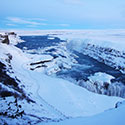


































Tulum – Mexico – Cenotes
May 2014
If you can drag yourself away from Tulum’s palm fringed beaches, I highly recommend that you make your way to one or more of the many nearby cenotes for a day of underwater fun and exploration.
For those who don’t know what cenotes are (I was one such person before this trip), they are natural sink holes, formed when a limestone cave collapses, to reveal an underground pool.
Some cenotes are completely open, like a lagoon, or entirely covered with a small opening at the top, while others fit somewhere in between. The water, which is either fresh or salt is incredibly clear, making cenotes the perfect environment for snorkelling and diving.
Swimming within the beautiful and mysterious underwater world of these natural pools was one of the most thrilling and wondrous experiences Nick and I had while travelling throughout the Yucatán Peninsular.
There are thousands of cenotes in the Yucatán and some are as close as 15 minutes down the road from Tulum’s centre. So there really is no excuse not to go.
Dos Ojos
Cenote Dos Ojos, meaning “two eyes” in Spanish, is the world’s third largest underwater cave system, and a must see and swim for snorkelers and divers wanting to explore this unique and fascinating underwater world.
The name Dos Ojos refers to the two adjoining cenotes connected by a large cavern, which are said to resemble a pair of eyes. I highly recommend that you visit both cenotes, as they each offer a unique subterranean landscape.
I was absolutely blown away by the beauty and tranquility of Dos Ojos, both above and below the surface of the water. Giant rock shelters shrouded by thick jungle, stunning stalactite formations, and beneath the water a mysterious world of limestone structures, hidden tunnels, and the blackness of the unknown.
Although I had been snorkelling many times before, floating through the water at Dos Ojos, was like nothing I had ever experienced. The sensation that occurred was that of resting on water. As I peered through my goggles, at my surrounds it felt as if time suddenly stood still. Motionless, I silently viewed colonies of tiny fish drifting ever so slowly with the gentle flow of the current. An incredible and a truly unforgettable experience!
If you’re more of an intrepid adventurer and hold an open water diving certificate, there is also the option to scuba dive. Diving promises the opportunity to see much more as the cenotes are connected by an underground tunnel system, which you can follow from one cenote to another.
Gran Cenote
Located just off the highway on the way to Cobá, this partially sheltered cenote was by far the busiest sink hole Nick and I visited. While the beauty of Gran (Grand) Cenote and its surrounding area can not be denied, I must admit that the boisterous crowds did distract a little from the usually tranquil setting.
All was forgiven and forgotten though, as soon as we immersed ourselves in the cool, clear waters of the cenote. An absolute welcomed relief from the sweltering 34 degree (Celsius) heat we were experiencing that day.
Similar to other cenotes, Gran Cenote offers fantastic snorkelling and diving, as well as an impressive collection of stalagmites and stalactites, some that are tens of thousands of years old. Nick and had a great time floating through and exploring the large cavernous chambers, from one opening to another.
While the stepped entrances into the cenote are lit by streams of sunlight, the further into the caves you go, the darker and more eerie they become. In some sections, our swim was tremendously creepy, thanks to a lack of natural light, the water’s changing temperatures, and a flock of noisy bats hanging (and swooping) overhead.
Zacil-Ha
Unlike the other cenotes, mentioned above, Zacil-Ha (meaning ‘clear water’) is small and completely open. It is also less crowded and less ‘showy’. Pulling into the car park it actually felt as if the place had been totally abandoned. There wasn’t even a person at the ticket desk.
While admittedly the lack of staff was not a great sign, Nick and I decided to continue down the jungle path. And boy am I glad we did, as we were greeted by a spectacular wide opening and within it an incredibly inviting, turquoise coloured pool.
Naturally, Nick and I were quick to get in. And with almost no crowd we only shared the cenote with a family of five, who were thoroughly enjoying themselves summersaulting and back flipping off the jumping platform into the crystal clear water below.
I still can’t get over how beautiful Zacil-Ha was. We stayed for about half an hour or so, although we could have easily stayed longer had it not been for the sudden burst of torrential rain.
In addition to the cenote, Zacil-Ha has changing rooms, outdoor showers, a small canteen, rental equipment, sun beds, cabanas, and plenty of shade from the surrounding trees. So you can really make a day of it.
Now, as for the missing staff, they were there. They just all happened to be huddled under a cabana eating lunch when we arrived.
Tip
If you end up snorkelling and don’t have the gear, hire beforehand at either the hotel you’re staying at or a local dive shop. That way you don’t have to keep paying for equipment at every new spot.
Dos Ojos
Getting There: From Tulum you can take a collectivo (mini bus) for M$25 ($2 USD) heading north and get dropped at the entrance.
Admission into the cenote costs M$100 ($8 USD) per person.
Gran Cenote
Getting There: A taxi from downtown Tulum costs around M$60 ($5 USD).
The entrance fee for one adult is M$100 ($8 USD).
Getting There: Located 2 km's west of Gran Cenote, sits Zacil-Ha. So please check the getting there info for Gran Cenote.
One adult ticket costs M$50 ($4 USD).

Chichén Itzá – Mexico
Apr 2014
The ancient Maya ruins of Chichén Itzá, lay inland 200 kilometres west of Cancún, and provide a magnificent display of Maya culture.
Built around AD 400, Chichén Itzá is one of the greatest Maya centres to have ever existed. At the peak of its civilisation (between AD 600 and AD 1200) Chichén Itzá was the powerful capital of the Maya world and a major political hub. It was also an area where the Maya sacrificed objects and humans as a way of worshipping the Maya rain god.
As a city, Chichén Itzá continued to thrive up until the 15th century, when it unexpectedly and rapidly declined, so much so that it was eventually abandoned. A mystery, which still baffles historians and archaeologists.
Today, Chichén Itzá is a recognised UNESCO World Heritage Site and covers an area of five square kilometres. The sacred site is filled with both historical beauty and natural charm. Mighty pyramids, towering temples, ball courts and decorative pieces, lie within the Yucatán’s thick jungle and reveal much about the sites 1000 years of history.
Indeed the heavily ‘restored’ ruins of Chichén Itzá, provide visitors with an incredibly detailed look at the living conditions and architectural prowess of the Maya.
The most distinguishable structure at Chichén Itzá is El Castillo, also known as the temple of Kukulkan. The impressive stepped pyramid highlights not only the Maya’s architectural genius, but also their exceptional understanding of astronomy and the solar system.
The pyramid’s four sides contain 365 steps (a step for each year), 52 panels (for each week in the solar year), and 18 terraces (for the 18 months in the religious year). Also, incredibly during the spring and autumn equinox, a stream of sunlight creates a shadowed image of a serpent, which appears to be slithering down the steps.
With such historical and cultural significance, and the yearly equinox spectacle it is hardly surprising that Chichén Itzá has become a major tourist stop on the traveller trail. In fact the site is one of the most visited attractions in all of Mexico. Approximately 1.2 million people visit each year.
Note
Keeping in mind that Chichén Itzá is an extremely popular day trip for visitors to the Yucatán (thanks to the site’s proximity to Cancún, Tulum, Medria and Vollidad), it is best to arrive early to avoid the sprawling crowds, as well as the blazing hot midday sun. Also, with little shade it is imperative that you pack a hat, some sunscreen and a bottle of water.

Cobá – Mexico
Apr 2014
Forty five kilometres west of Tulum lies Cobá, one of the oldest Maya settlements in all of Latin America. The city is thought to have been an important commercial trading post and link between the cities on the coast and those inland.
At the peak of its civilisation (between AD 200 and AD 900), Cobá is believed to of housed some 50,000 inhabitants and covered an area of 50 square kilometres, making it one of the largest Maya cities to have ever existed.
Today, Cobá’s spectacular ruins (there are thought to be over 6,000 structures) are nestled deep within the Yucatán’s thick jungle.
Temples, towering pyramids and other stone structures are dotted throughout the site and are connected by an extensive network of ceremonial white roads called sacbeobs. These impressive structures stand as monuments to the past and allow visitors to leap back in time.
Considering how long these structures have been standing, it is incredible that visitors to the archeological site are actually encouraged to climb upon them.
Indeed, at Cobá, visitors can climb The Great Pyramid, also known as Nohoch Mul (Big Mound). At 42 metres tall, Nohoch Mul is the tallest Maya structure in the Yucatán Peninsula. For those who brave the steep climb, a spectacular view overlooking the surrounding jungle landscape awaits.
Out of all the ruins Nick and I visited in Mexico, Cobá was by far our favourite. This was mainly due to it not being as ‘polished’ as some of the other sites we explored. We found that with little reconstruction, Cobá offered a different and much more authentic experience.
We also enjoyed the vastness of the Cobá site, and at times we felt as if we had the entire place to ourselves. Having said that, I still recommend arriving to Cobá early, to avoid the midday crowds. Also, the site is spread out, so hiring a bike (which you can rent within the grounds) can be a fun and an inexpensive alternative to walking.

Tulum – Mexico – Ruins
Apr 2014
The ruins of Tulum lie three kilometres northeast of the town centre, and sit dramatically between the jungle and the Caribbean sea.
Built around AD 1200 by the Maya (indigenous inhabitants of present day Mexico), the walled settlement is an extremely important site and major point of interest in Mexico. Not only is it one of the last cities built and inhabited by the Maya but it is also one of the best preserved Maya sites.
At its height (between the 13th and 15th century), Tulum was a flourishing commercial trade port, however by the end the 16th century the site was abandoned completely. A mystery which, along with the decline of the Maya world, still puzzles historians and archeologists today.
While the architecture resembles that of other Maya sites, the scale of the city is far smaller and not as grand. That said, the structures that remain are truly impressive and provide a valuable glimpse into the living conditions of the Maya civilisation.
The area where the ruins lie is relatively compact, so you can gain a fair appreciation of the historical buildings in about an hour or so. What will make or break your visit however, is your arrival time.
The site is open between 8am and 5pm. From 9am tour buses fill the car park, dropping off a constant stream of visitors. Therefore, I strongly suggest heading to the site at 8am when the gates open.
The early start will almost certainly guarantee an empty lot. Well, apart from a handful of other early risers and a colony of sun seeking iguanas. Otherwise, wait until the end of the day when all the tour buses have left.

Tulum – Mexico – Where To Stay
Apr 2014
From luxury hotels to rustic cabañas, Tulum offers visitors a range of accommodation types, fit for every budget.
Mango Tulum
Having stayed at my fair share of hostels I can honestly say that Mango Tulum is truly a budget-conscious travellers dream. Affordable, secure, comfortable and exceptionally clean. There’s even a beautifully kept garden, an inviting outdoor pool and what seems like a never ending supply of cake!
The owner Mark is a wonderful host. He is warm, welcoming, and has a wealth of knowledge about the local area, which he is more than happy to share with his guests.
Every recommendation Nick and I received from Mark, whether is was a suggestion on where to eat or advice on how to avoid the crowds at nearby tourist sites, was absolutely spot on.
Located near the centre of town, Mango Tulum is a great place to base yourself while exploring Tulum and surrounds, where you’ll find ruins, beaches and cenotes (natural sink holes). It’s definitely the type of place that you book for three nights and end up staying an entire week.
With only a handful of private and 4 person dorm rooms, Mango Tulum is not an overly big place. As such the hotel has an extremely peaceful and laid back vibe.
Nick and I thoroughly enjoyed our time at Mango Tulum (7 nights in total), so much so that we did not want to leave.
Papaya Playa Project
Papaya Playa Project (PPP) is an eco-friendly resort, surrounded by thick jungle, on an unspoilt stretch of the Caribbean coastline.
Lured by photos on the internet of PPP’s palm fringed beach and thatched roofed huts, Nick and I could not resist booking a couple of nights.
We justified this uncharacteristic splurge on accommodation, as the nights we intended to stay fell over ‘birthday week’. Also we told ourselves that PPP would provide us with ‘a much needed’ break from the string of hostels and budget hotels we had already booked.
Needless to say we had a truly fabulous stay, which was made even better by our free room upgrade!
Over the few days we stayed at PPP, Nick and I didn’t do all that much, but that’s the whole point of staying at a place like this. We lapped up the gorgeous surrounds and the incredible views, and happily gave into temptation, spending our days eating and reading, before heading to the beach again.
While we were fortunate to stay in one of the cabañas sprawled along the ocean front, not all of the resort’s lodgings are. Some are a little further back, reached by a garden path, while others are perched atop the coastline’s natural rocky ledge.
Some of the bungalows are simple wooden huts, while others are more flashy, high arched villa type abodes. Whatever the case you are sure to have a splendid time at PPP!
Address: Calle Polar (btw Avenida Cobe & Calle Escorpion Norte)
Address: Carretera Tulum - Broca Paila
Pingback: Cenotes